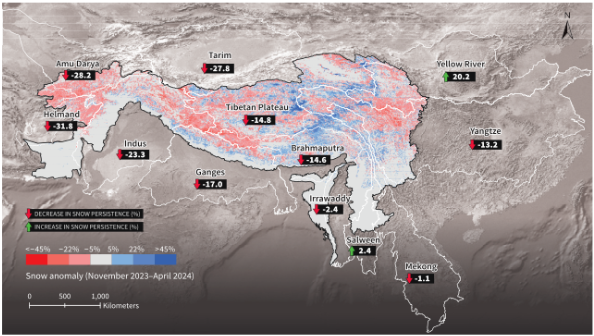Table of Contents
Context
- The Ganga river basin, India’s largest, experienced a record low snow persistence in 2024, as reported by the International Centre for Integrated Mountain Development (ICIMOD).
- Similar declines were noted in the Brahmaputra and Indus basins, posing significant threats to water supplies for millions.
What is Snow Persistence?
- Snow persistence is the fraction of time snow is on the ground.
- When this snow melts, it provides water to people and ecosystems.
Snow Persistence and Hindu Kush Region
- It is crucial for providing water through snowmelt to the Hindu Kush Himalaya (HKH) region.
- This snowmelt is the primary water source for streams in the region, contributing 23% of the runoff to 12 major river basins annually.
- The HKH mountains, spanning 3,500 km across eight countries (Afghanistan, Bangladesh, Bhutan, China, India, Nepal, Myanmar, and Pakistan), are termed the “water towers of Asia” due to their role in originating ten significant river systems.
- These rivers supply water to nearly one-fourth of the global population and serve as a freshwater source for 240 million people in the HKH region.
Report Findings of International Centre for Integrated Mountain Development (ICIMOD)
The 2024 HKH snow update analysed data from 2003 to 2024, showing significant fluctuations in snow persistence between November and April.
- Ganga Basin: Snow persistence in 2024 was 17% below the historical average, the lowest in 22 years. The previous low was in 2018 at 15.2% below normal, while in 2015 it was 25.6% above normal.
- Brahmaputra Basin: Persistence was 14.6% below normal in 2024, slightly better than 2021’s 15.5% below normal.
- Indus Basin: Snow persistence fell 23.3% below normal in 2024, although some lower altitude areas saw excesses.
- Amu Darya Basin (Central Asia): Recorded its lowest snow persistence in 2024 at 28.2% below normal.
- Helmand River Basin (Iran and Afghanistan): Nearly 32% below normal in 2024, surpassing the 2018 record.
- Mekong River Basin: Slightly below normal persistence.
- Instances of Higher Snow Persistence: In 2024, China’s Yellow River basin saw snow persistence exceed the normal value by 20.2%.
- The interaction between the East Asian winter monsoon’s cold, dry air from Siberia and Mongolia with moist air from the Pacific Ocean resulted in increased snowfall over higher altitudes.

Causes of Lower Snow Persistence
- Weak western disturbances, exacerbated by climate change and global warming, are the primary reasons for lower snow persistence in 2024.
- These disturbances, originating over the Mediterranean Sea, Caspian, and Black Seas, bring winter rain and snow to the HKH region.
- Persistently high sea-surface temperatures in these regions weakened and delayed their arrival, resulting in reduced winter precipitation and snowfall.
- Global warming has intensified and prolonged La Niña–El Niño conditions, influencing global weather patterns, including those affecting western disturbances.
- The HKH region is experiencing temperature increases higher than the global average, making the Paris Agreement’s 1.5 degrees Celsius limit insufficient for protecting the snow and ice in this region.
Importance for India
- Snowmelt contributes significantly to water supplies in the Ganga (10.3%), Brahmaputra (13.2%), and Indus (around 40%) river basins.
- Lower snow persistence in 2024 could impact water availability, especially in the Indus Basin if early-season rainfall is deficient.
Solutions
- Experts suggest reforestation with native tree species to help retain more snow, improved weather forecasting, and early warning systems to prepare for water stress.
- Enhancing water infrastructure and developing policies for snow-receiving areas are also crucial.
- Community involvement in decision-making and promoting regional cooperation are vital for sustainable solutions.
- Reducing emissions is essential to mitigate rising sea-surface and ground temperatures that lower snow persistence.
- Building political will for government and business leaders to reduce fossil energy consumption and production, especially among G-20 countries (responsible for 81% of emissions), is critical for a liveable future.


 Somaliland Explained: Location, History,...
Somaliland Explained: Location, History,...
 Signals from the Indian Economy: What Ke...
Signals from the Indian Economy: What Ke...
 Reforms Needed in India’s Political Fu...
Reforms Needed in India’s Political Fu...

























